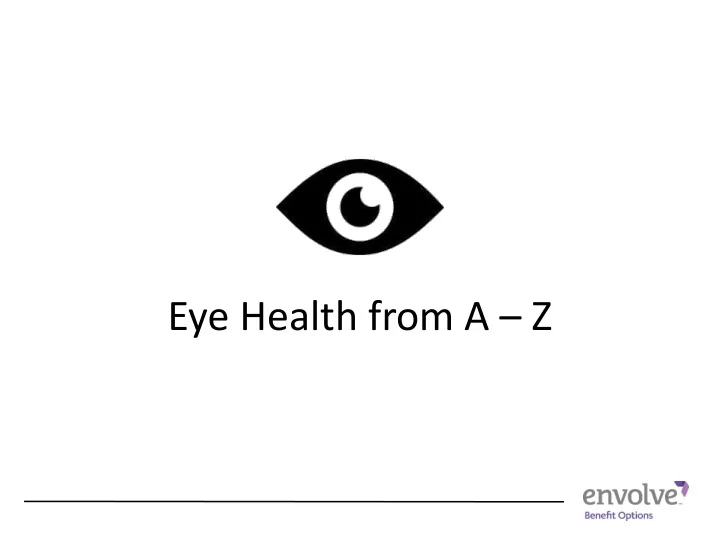

Eye Health from A – Z
Did You Know? 13.5 Vision problems affect nearly million children in the U.S. Students, especially young ones, may not know that what they are experiencing is a vision problem Leads to frustration and worsening academic performance 75% of all blindness and vision impairment is either preventable or treatable
• Discovering vision problems Start Young! early on in a child’s life is an important part of helping him or her do well in school. • Avoid frustration • Make reading easier • Make learning more enjoyable • In the case of some vision conditions, early detection and treatment is the only way to prevent loss of sight in the afflicted eye
Common Eye Disorders in Children Nearsightedness (myopia) • Most common visual problem among students • Close objects are clear, far-away objects are blurry • Students may squint to see blackboard or presentation materials • Can be corrected with corrective lenses such as glasses or contact lenses Farsightedness (hyperopia) Astigmatism • Close objects are blurry, far-away • Often co-occurs with nearsightedness objects are clear or farsightedness • Students may squint while reading or • A type of refractive error caused by an hold reading material farther away abnormally shaped cornea • Can be corrected with corrective from face than normal • Can be corrected with corrective lenses such as glasses or contact lenses such as glasses lenses
Common Eye Disorders in Children Strabismus Lazy Eye (Amblyopia) • • Issue with eye muscles One eye is stronger than the other • • Student’s eyes appear to be Student may show signs of focusing on two different points strabismus, but the two do not always co-occur • Often co-occurs with amblyopia • Over time, the brain may begin to • Glasses or eye muscle exercises disregard signals from the weaker can treat strabismus. Sometimes eye surgery is needed. • If it is not detected early, amblyopia can lead to a permanent loss of sight in the weaker eye • This disorder is only detectable through an eye exam from an optometrist or ophthalmologist
Common Eye Disorders In Seniors • By age 65, one in three Americans have some vision-impairing eye disease • Most don’t know it— often there are no early warning signs • Poor sight is not a natural part of aging • You can take measures to preserve your sight • Have eye disease detected and treated early • Visit an eye doctor at least every 1-2 years
Common Eye Conditions in Seniors • Presbyopia • Diminished ability to focus on near objects • Results in need for reading glasses or bifocals • Dimming of vision • Slight loss of retinal function • Beginning cataract(s) • Cataract(s) • Caused by eye’s lens becoming opaque • Smoking increases incidence of some types • Nearly everyone will have them by age 90
Common Eye Conditions in Seniors • Dry eye • Caused by insufficient tears or by eyelid inflammation • Persistently painful, stinging or itchy eyes • Glaucoma • Gradually destroys optic nerve • Peripheral (side) vision lost first • Essential for seniors to have comprehensive eye exam at least every 1-2 years • AMD (age-related macular degeneration) • Leading cause of blindness and irreversible vision loss in seniors • Gradually destroys central retina (macula) needed for sharp vision • Three times more common in smokers
Facts about Eye Health – Worldwide • Somewhere in the world, someone goes blind every 5 seconds. • A child goes blind every minute. • 80% of all blindness is preventable or curable. • It is estimated that at least 7 million people go blind every year. • Worldwide some 180 million people are blind or visually disabled — the equivalent of two-thirds of the entire U.S. population. • Rates of blindness will double by the year 2020 unless prevention efforts are intensified. • People in developing countries represent 90 percent of the world’s blind population and are 10 times more likely to go blind than those in developed countries. • Africa averages just one ophthalmologist for every 1.25 million people http://www.eyecareamerica.org/
Facts about Eye Health in America • By age 65, one in three Americans has some form of vision impairing eye disease. • Of the 119 million people in the United States who are age 40 or over, 3.4 million are visually impaired or blind. This level of blindness and visual impairment costs more than $4 billion annually in benefits and lost income. • In California, over 13,000,000 people are age 40 or over, and 356,000 are visually impaired or blind. This represents approximately 10% of all visual impairment and blindness in the United States. • People with diabetes are 25 times more likely to become blind than people without diabetes. • Glaucoma is one of the leading causes of blindness in the United States, and the most common cause of blindness among African Americans. • Nearly three million people have glaucoma, but half do not realize it because there are often no warning symptoms http://www.eyecareamerica.org/
Recommend
More recommend